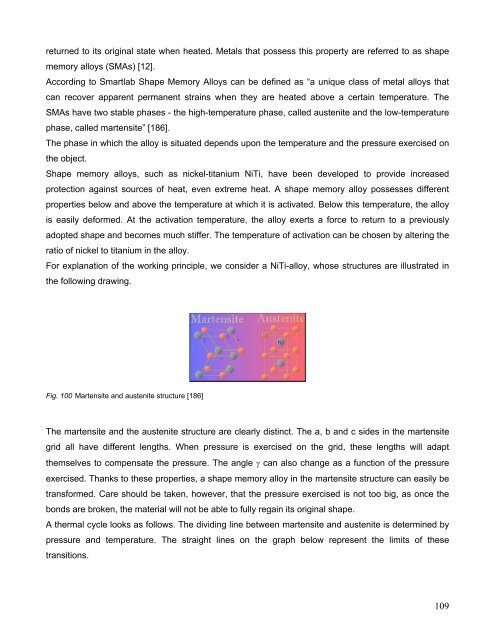Clevertex - Grado Zero Espace Srl
Clevertex - Grado Zero Espace Srl
Clevertex - Grado Zero Espace Srl
You also want an ePaper? Increase the reach of your titles
YUMPU automatically turns print PDFs into web optimized ePapers that Google loves.
eturned to its original state when heated. Metals that possess this property are referred to as shape<br />
memory alloys (SMAs) [12].<br />
According to Smartlab Shape Memory Alloys can be defined as “a unique class of metal alloys that<br />
can recover apparent permanent strains when they are heated above a certain temperature. The<br />
SMAs have two stable phases - the high-temperature phase, called austenite and the low-temperature<br />
phase, called martensite” [186].<br />
The phase in which the alloy is situated depends upon the temperature and the pressure exercised on<br />
the object.<br />
Shape memory alloys, such as nickel-titanium NiTi, have been developed to provide increased<br />
protection against sources of heat, even extreme heat. A shape memory alloy possesses different<br />
properties below and above the temperature at which it is activated. Below this temperature, the alloy<br />
is easily deformed. At the activation temperature, the alloy exerts a force to return to a previously<br />
adopted shape and becomes much stiffer. The temperature of activation can be chosen by altering the<br />
ratio of nickel to titanium in the alloy.<br />
For explanation of the working principle, we consider a NiTi-alloy, whose structures are illustrated in<br />
the following drawing.<br />
Fig. 100 Martensite and austenite structure [186]<br />
The martensite and the austenite structure are clearly distinct. The a, b and c sides in the martensite<br />
grid all have different lengths. When pressure is exercised on the grid, these lengths will adapt<br />
themselves to compensate the pressure. The angle γ can also change as a function of the pressure<br />
exercised. Thanks to these properties, a shape memory alloy in the martensite structure can easily be<br />
transformed. Care should be taken, however, that the pressure exercised is not too big, as once the<br />
bonds are broken, the material will not be able to fully regain its original shape.<br />
A thermal cycle looks as follows. The dividing line between martensite and austenite is determined by<br />
pressure and temperature. The straight lines on the graph below represent the limits of these<br />
transitions.<br />
109

















